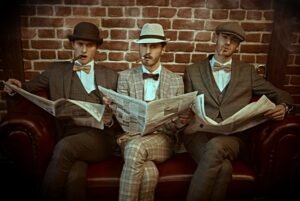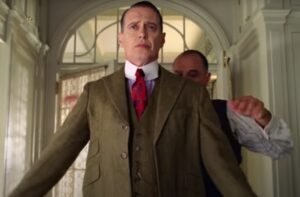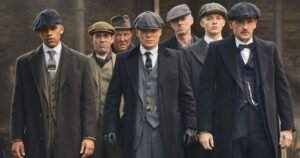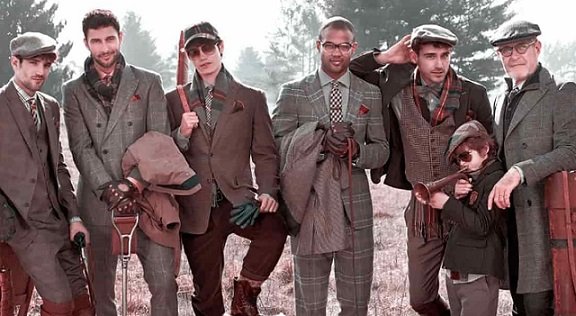Introduction to Male 1920s Fashion
The Male 1920s Fashion were a decade of significant cultural transformation, marked by major shifts in social norms, technological advancements, and, of course, fashion. Known as the “Roaring Twenties,” this era was a time of excess, excitement, and change—especially for men’s fashion. With the rise of the Jazz Age, men’s clothing became bolder, more refined, and filled with the kinds of distinctive characteristics that still influence fashion today.
In this comprehensive guide, we’ll take a deep dive into the world of male 1920s fashion, exploring the defining elements, key styles, and the cultural and historical forces that shaped the way men dressed during this iconic decade.
Table of Contents:
- The Cultural and Social Influence on 1920s Fashion
- Key Elements of Male 1920s Fashion
- Suits
- Shirts and Ties
- Hats
- Shoes and Boots
- Iconic Fashion Figures of the 1920s
- Popular Styles of the 1920s for Men
- The Sack Suit
- The Double-Breasted Suit
- The Morning Coat
- Accessories in 1920s Men’s Fashion
- Pocket Watches
- Cufflinks
- Ties and Cravats
- Male 1920s Fashion in Cinema
- The Influence of the Jazz Age on Men’s Fashion
- How the 1920s Men’s Fashion Still Impacts Modern Trends
- Conclusion
- Disclaimer
1. The Cultural and Social Influence on 1920s Fashion

The 1920s were a time of transition, marked by major shifts in how society viewed class, wealth, and individual identity. The aftermath of World War I, combined with the roaring economic boom, gave rise to an affluent, confident society that sought to express itself through bold fashion choices. Men’s fashion in the 1920s reflected the era’s embrace of modernity, a sense of liberation, and a desire for luxury.
Before the 1920s, men’s fashion had been more restrained and formal, largely governed by the principles of Victorianism and Edwardian aesthetics. However, the Jazz Age opened the door for more relaxed, yet still highly polished, styles. The war’s impact on everyday life made men more attuned to convenience, with functional clothing becoming a key theme in the fashion landscape.
As the century progressed, the fashion industry began to recognize men’s clothing as more than just practical—it was a way to make a statement. This is where the male 1920s fashion truly began to shine, offering a refined yet adventurous approach to menswear.
2. Key Elements of Male 1920s Fashion
Suits
Suits were the cornerstone of men’s fashion in the 1920s. Unlike the stiff, form-fitting suits of previous decades, 1920s men’s suits were looser and more relaxed, with a focus on comfort and elegance. A standard male suit during this time typically consisted of a well-tailored jacket and trousers, often worn with a waistcoat.
Key characteristics of 1920s suits include:
- Boxy and Loose Fit: A departure from the more tailored suits of previous decades.
- Wide Lapels: Lapels were larger and more pronounced than those from the early 1900s.
- High-Waisted Trousers: Trousers were worn higher on the waist, giving a flattering silhouette.
Shirts and Ties
Men’s shirts in the 1920s were typically made from cotton or linen and came in a variety of colors, from soft pastels to classic whites. The shirts often had stiff, detachable collars, a characteristic feature of this period.
Ties and Cravats were also prominent during the 1920s. Bow ties were a go-to option for evening wear, while regular neckties were often more colorful and patterned during the day.
Hats
No man was considered fully dressed in the 1920s without a proper hat. Fedoras, flat caps, and the ever-popular boater hat were all staple pieces. Hats were considered essential for completing any outfit, especially when stepping outside.
Fedora: This classic felt hat with a wide brim was a popular choice for men, often associated with the urban, sophisticated look. Boater Hat: Worn during the summer months, this straw hat was a key part of resort and casual fashion. Flat Cap: Worn by men of all social classes, this hat was more relaxed, typically made of tweed.
3. Iconic Fashion Figures of the 1920s

Several notable figures from the 1920s left an indelible mark on men’s fashion, from actors and musicians to businessmen. One of the most iconic was Cary Grant, who became synonymous with smooth sophistication and tailored suits. Grant’s impeccable sense of style set trends that continue to influence menswear today.
Another iconic figure was Errol Flynn, known for his adventurous and more laid-back approach to fashion, embodying the relaxed yet elegant style of the era. Musicians like Louis Armstrong and Duke Ellington also contributed to the widespread popularity of fashionable, flamboyant clothing during the Jazz Age.
4. Popular Styles of the 1920s for Men
The Sack Suit
One of the most iconic styles of the 1920s was the sack suit, a type of suit with a loose, boxy fit that was a complete departure from the form-fitting jackets of the past. The sack suit typically featured:
- A soft, unstructured shoulder
- Single or double-breasted design
- Wide lapels
This style was often seen as a symbol of modernity, offering men greater freedom of movement.
The Double-Breasted Suit
The double-breasted suit, which had two sets of buttons on each side of the front, also made a strong appearance during the 1920s. It was more formal and often worn for important events or business meetings. It added a sense of power and formality, giving the wearer a more authoritative presence.
The Morning Coat
The morning coat, characterized by its long tails in the back and shorter front, was typically worn for formal day events. It remained a hallmark of upper-class fashion during the 1920s, especially in British society.
5. Accessories in 1920s Men’s Fashion
Accessories played a major role in men’s fashion during the 1920s, adding finishing touches to an outfit. Popular accessories included:
Pocket Watches
The pocket watch was a stylish, functional accessory worn by many men in the 1920s. It often served as a statement of wealth and refinement.
Cufflinks
Cufflinks were essential for adding sophistication to any formal outfit. Many featured intricate designs, from simple metals to luxurious, gemstone-studded pieces.
Ties and Cravats
Bow ties were widely worn for evening events, while regular neckties were an essential part of everyday attire. Silk ties, often patterned or striped, were especially popular.
6. Male 1920s Fashion in Cinema

Hollywood played a pivotal role in shaping 1920s fashion. The silver screen brought the glamour of the Jazz Age into homes around the world, with actors like Clark Gable and Douglas Fairbanks influencing men’s fashion.
Movies helped popularize the sophisticated, dashing image that men aspired to, with fashion becoming an integral part of cinematic storytelling.
7. The Influence of the Jazz Age on Men’s Fashion
The Jazz Age had a profound influence on both social culture and fashion. As the jazz movement blossomed, so did the idea of freedom, creativity, and breaking traditional boundaries. Men of the time took inspiration from jazz musicians, adopting more daring clothing choices, including bright colors, flashy accessories, and stylish hats.
8. How the 1920s Men’s Fashion Still Impacts Modern Trends
The style of the 1920s continues to influence modern menswear. From the slim suits worn by today’s top actors and musicians to the resurgence of fedora hats in recent years, many of the trends from the 1920s are alive and well today. The modern “vintage” aesthetic is rooted in the bold yet refined looks that dominated the Jazz Age.
9. Conclusion
The 1920s remain one of the most stylish decades in fashion history, with the bold sophistication of male 1920s fashion setting the stage for much of what we wear today. From the relaxed sack suits to the iconic fedoras and accessories, the styles of the Jazz Age continue to captivate fashion enthusiasts around the world.
Disclaimer
The information in this article is for general informational purposes only. While every effort has been made to ensure the accuracy and reliability of the content, fashion trends are subjective and may vary over time. For personalized style advice, we recommend consulting with a professional stylist or fashion consultant.
